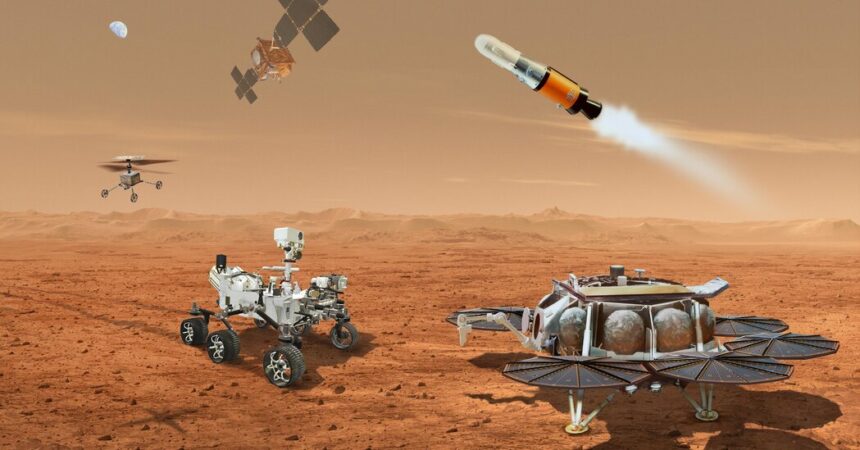The cost of a proposed NASA mission to gather rocks on Mars and return them to Earth is spiraling upward and slipping further into the future. So on Monday, space agency officials asked for ideas on simplifying the mission and trimming its price tag.
“The bottom line is that $11 billion is too expensive,” Bill Nelson, the NASA administrator, said during a news conference on Monday. “And not returning samples until 2040 is unacceptably too long.”
The mission, known as Mars Sample Return, is central to the search for signs that life may have existed on the red planet. The idea is to bring samples of rock and soil back to Earth so that scientists can prod and poke at them using their most sophisticated tools.
NASA had hoped that Mars Sample Return would cost $5 billion to $7 billion, and that the rocks would arrive on Earth in 2033.
But last fall, a panel that reviewed the mission concluded that the cost was likely to be much higher, from $8 to $11 billion. NASA officials said on Monday that after they looked over the review, they agreed with that cost estimate, and that, given budget constraints, the current Mars Sample Return mission would not be able to deliver the rocks before 2040.
On Tuesday, NASA plans to issue a “request for information” seeking alternative plans from aerospace companies as well as experts within NASA, with proposals to be due on May 17. Of those, NASA would finance several of the proposals, with studies finishing later this year. Then NASA would have to decide its next step.
“We’re going to need to go off to some very innovative new possibilities for design and certainly leave no stone unturned,” said Nicola Fox, the associate administrator for NASA’s science mission directorate.
At the same time, she said she hoped for “traditional, tried-and-true architectures” that would reduce the risk of delay and failure.
“This is the Hail Mary,” Casey Dreier, the chief of space policy at the Planetary Society, a nonprofit organization that supports space exploration, said in an interview. Mr. Dreier said he had thought that NASA would simply announce a delay, which would reduce the amount it was spending on the mission in a given year, while adding to the final price tag.
“That would have been an easier way, from our perspective, to preserve the plan as it existed, to add certainty where there’s uncertainty,” Mr. Dreier said.
The first phase of Mars Sample Return is already underway. NASA’s Perseverance rover, which landed on Mars in 2021, has been drilling and collecting cylindrical samples of rock and soil in the Jezero Crater, which contains an ancient river delta.
The current Mars Sample Return plan, devised by NASA’s Jet Propulsion Laboratory in California, involves a complex choreography. First, a new robotic spacecraft would land near the Perseverance rover, which would then hand over about 30 of its rock samples. Those would then be launched into orbit around Mars. Yet another spacecraft, from the European Space Agency, would retrieve those samples, take them back to Earth and drop them off within a small disk-shaped vehicle that would land in a Utah desert.
To undertake a mission that would move more quickly and at a lower cost, one idea might be to leave some of the samples behind on Mars. That would reduce the size and complexity of the spacecraft needed.
If scientists were forced to choose which rocks they want most, “I think that will be some very, very lively and very exciting scientific chatter,” Dr. Fox said.
In February, Mr. Dreier wrote an essay about whether NASA could turn to Elon Musk’s SpaceX for a cheaper robotic Mars Sample Return mission. SpaceX’s mammoth Starship rocket is being designed with the goal of sending people to Mars.
“The answer is almost certainly ‘no,’” Mr. Dreier wrote then. “At least, not anytime soon.”
But if Mr. Musk and SpaceX are interested, NASA is now willing to listen. Mr. Dreier said that SpaceX would need to solve numerous technical challenges, including how it could produce propellants for the return trip.
“Is this getting to be less, or more expensive and time-consuming and risky than the original J.P.L. concept?” Mr. Dreier said, referring to the Jet Propulsion Laboratory’s plan.
SpaceX did not respond to a request for comment.
Mr. Dreier said that, as an optimist, perhaps Mr. Nelson was right and that someone would offer a better solution.
But he added that NASA’s announcement on Monday could be a pretext for canceling the mission, or trying to convince Congress that it indeed needed $11 billion.
“It may just be that people don’t want to accept that that’s what it costs,” he said. “I guess that’s one of the things we’ll find out.”

